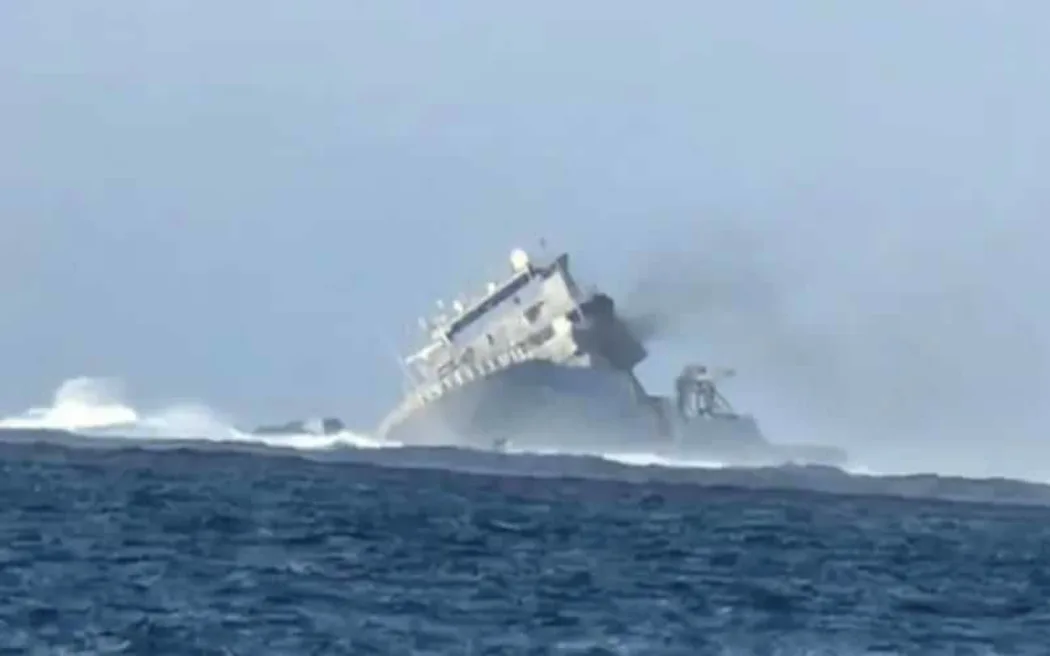
The HMNZS Manawanui grounded and sank off the coast of Samoa as a result of human error, an interim report has found.
The Royal New Zealand Navy ship hit a reef on the southern side of Samoa on 5 October while conducting survey operations.
Chief of Navy Rear Admiral Garin Golding launched a Court of Inquiry afterwards and has just released its interim findings.
“The direct cause of the grounding has been determined as a series of human errors which meant the ship’s autopilot was not disengaged when it should have been,” Golding said.
“The crew did not realise Manawanui remained in autopilot and, as a consequence, mistakenly believed its failure to respond to direction changes was the result of a thruster control failure.”
Golding said “standard procedures” should have prompted the ship’s crew to check the vessel was under manual control, rather than autopilot.
“This check did not occur. Remaining in autopilot resulted in the ship maintaining a course toward land, until grounding and eventually stranding.”
Golding said why this had happened and what would come next were still being worked on as part of the wider Court of Inquiry, expected to be completed in the first quarter of next year.
A separate disciplinary process would commence after the Inquiry was over given the sinking was caused by human error, he said.
“To provide some immediate assurance, we have conducted a series of audits in the Fleet and looked to implement initial lessons identified from the interim report around training, risk management, and improving relevant orders, instructions and procedures.”
Golding said he was grateful for the support from the Transport Accident Investigation Committee (TAIC), the Royal Australian Navy, and Royal New Zealand Air Force for their support to the Court of Inquiry investigation.
Evidence had been collected through interviews with the crew, expert witnesses and data from the ship’s recordings to find the primary cause of the disaster.
He said the Defence Force was thankful for Samoa’s ongoing support and remained committed to working with Samoan authorities on the response.
“I want to reassure the public of New Zealand that we will learn from this situation and that it is on me, as the Chief of Navy, to earn back your trust.”
The Interim Court of Inquiry report will not be released in full, with a public version of the final Court of Inquiry to be made available around March 2025.
Defence Minister Judith Collins said the finding was “extremely disappointing”.
“This is really not Navy for six. Personnel are obviously extremely upset about this.
“I think you’re just as shocked as we all are but I don’t think anyone can fault the Navy for standing up and saying this is what happened, we own it and we’re going to fix it.”
Collins said it was fortunate no one had died.
“I think that New Zealanders can know that it was a terrible day. Fortunately, it wasn’t a mess [or] a tragic day. Lives were not lost.”
Golding confirmed three personnel (the officer in control of the ship, the officer supervising and the commanding officer) would go through a disciplinary process next year.
“On the day … the person in control should have leant over to that panel and checked whether the screen said autopilot or not.”
“It’s a human error. We are humans. We make mistakes and nobody shows up on the day to have a bad day.”
Collins said the Deputy Chief of Navy Commodore Andrew Brown, who was currently based in Samoa, had been keeping the Samoan government up to date.
“I think there’s a lot of trust, as there should be between Samoa and New Zealand, and the Samoan government have been absolutely great at standing up and helping wherever they’ve been asked.”
“They can have full confidence that we’re doing everything we can.”
Golding said weather-dependant salvage operations would start on the week of 16 December with a plan to complete them before the cyclone season.
The $100 million vessel was insured for salvaging operations but not replacement.
(Sourced: RNZ News)